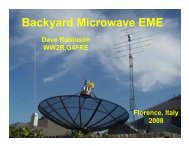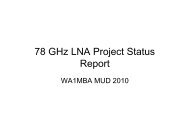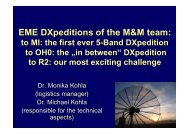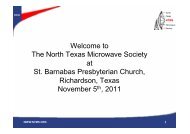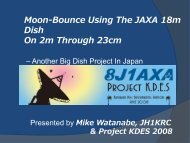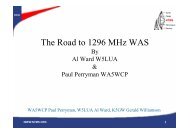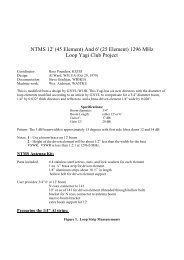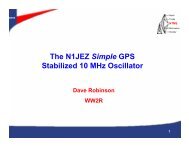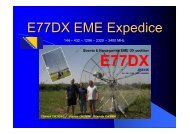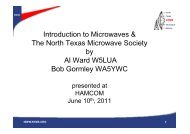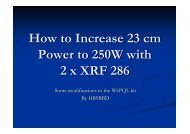The Excitement & Challenges of 24 GHz EME - NTMS
The Excitement & Challenges of 24 GHz EME - NTMS
The Excitement & Challenges of 24 GHz EME - NTMS
Create successful ePaper yourself
Turn your PDF publications into a flip-book with our unique Google optimized e-Paper software.
<strong>The</strong> <strong>Excitement</strong> &<br />
<strong>Challenges</strong> <strong>of</strong><br />
<strong>24</strong> <strong>GHz</strong> <strong>EME</strong><br />
By<br />
Al Ward W5LUA<br />
August 17, 2012
Introduction<br />
►History<br />
►Early Activity<br />
►Present Activity<br />
►Equipment<br />
►<strong>Challenges</strong><br />
►Summary
<strong>The</strong> First <strong>24</strong> <strong>GHz</strong> <strong>EME</strong> QSO<br />
►<strong>The</strong> First <strong>24</strong> <strong>GHz</strong> <strong>EME</strong> QSO occurred on<br />
August 18, 2001 when VE4MA contacted<br />
W5LUA<br />
►Years <strong>of</strong> work optimizing feeds & dishes ,<br />
LNAs, and optimizing TWTs and power<br />
supplies<br />
►Our last missing link was the TWT and<br />
thanks to Paul Drexler, W2PED, both Barry<br />
and I were able to generate some power.
<strong>24</strong> <strong>GHz</strong> <strong>EME</strong> Activity<br />
► By 2008, several other stations had become active<br />
including RW3BP, AA6IW, VE7CLD, OK1UWA,<br />
LX1DB, G4NNS, DK7LJ, DF1OI, OK1KIR, PA0EHG,<br />
and DL7YC<br />
► More recently F2CT, OZ1FF, RK3WWF, IK2RTI and<br />
F1PYR have been added to the list <strong>of</strong> active<br />
stations from Europe<br />
► Recently, JA6CZD became the first Asian to make<br />
an <strong>EME</strong> QSO on <strong>24</strong> <strong>GHz</strong> by working OK1KIR.<br />
Congrats to both stations!
<strong>The</strong> 1.25 cm Amateur Band<br />
►In the US, the 1.25 cm band extends from<br />
<strong>24</strong>,000 to <strong>24</strong>,250 MHz<br />
►Original <strong>EME</strong> activity was centered around<br />
<strong>24</strong>,192 MHz which was the center <strong>of</strong><br />
terrestrial activity in the US and Canada.<br />
►Migrated to <strong>24</strong>048 MHz which is a primary<br />
frequency allocation in Europe and also<br />
where amateur satellite operation has taken<br />
place in the past.
►What does it take<br />
Equipment
Early <strong>24</strong> <strong>GHz</strong> <strong>EME</strong> dish at W5LUA<br />
Andrews 3M prime focus dish with additional back structure to<br />
enhance parabolic curve<br />
Scientific Atlanta positioner with additional drive reduction to<br />
slow down speed
VE4MA 2.4 M Offset Fed Dish
Present 2.4 M Offset Fed Dish at W5LUA
2.4M Az/El & Az Encoder
Feed/LNA/Waveguide Relay
Peltier Cooler for LNA
Cooling <strong>24</strong> <strong>GHz</strong> LNA @ DF1OI
Feed Experimentation
Modified W2IMU <strong>24</strong> <strong>GHz</strong> feed with flare used<br />
by W5LUA on 2.4M <strong>of</strong>fset fed dish with f/d=.7<br />
1.6” (40.6mm)<br />
.4375” (11.1mm)<br />
WR-42<br />
Ө<br />
1.9” (48.3mm)<br />
.93” (23.6mm)<br />
3.0” (76.2mm)<br />
1.5”(38mm)<br />
1.9” (48.3mm)<br />
.615”(15.62mm)<br />
~.1” (2.54mm) behind face <strong>of</strong> horn<br />
Ө ~ 23 o
DMC 23 <strong>GHz</strong> Modules
Various other 23 <strong>GHz</strong> Modules
W5LUA <strong>24</strong>048 MHz Transverter
Thompson TH-3864 100 watt TWT<br />
with magnet tuning
K5GW Tracking S<strong>of</strong>tware
Optimized Dual Mode F2L x L3.10L
Moon Noise vs Lunar Phase<br />
Ref: John D. Kraus,<br />
Radio Astronomy,<br />
McGraw-Hill,1966, pp<br />
339
<strong>The</strong> Real <strong>Challenges</strong><br />
►Doppler<br />
►Spatial Offset<br />
►Atmospheric Absorption<br />
►So when is Perigee
<strong>The</strong> Doppler Effect<br />
► Doppler effect is the change in frequency <strong>of</strong> a<br />
signal that occurs as a result <strong>of</strong> the source and the<br />
observer moving relative to each other.<br />
► As the source and/or observer are moving closer<br />
to each other , the frequency will increase and as<br />
the source and/or observer are moving further<br />
away from each other the frequency will decrease.<br />
► <strong>The</strong> doppler effect scales proportionally with<br />
frequency
<strong>The</strong> Doppler Effect<br />
► Since the relative angular velocity <strong>of</strong> the earth is<br />
faster than the orbit <strong>of</strong> the moon, the doppler is at<br />
a maximum at both moon rise and moon set and<br />
zero around zenith.<br />
► <strong>The</strong>refore… at moon rise the doppler shifted signal<br />
will be highest in frequency (positive) gradually<br />
decreasing to zero <strong>of</strong>fset from the transmitted<br />
frequency at zenith and continuing to decrease to<br />
its lowest frequency (negative) at moon set.<br />
► Slight hook effect at the edges <strong>of</strong> the earth
F1EHN <strong>EME</strong> Program at W5LUA<br />
Moon rising at W5LUA and near zenith at LX1DB<br />
Self Doppler at LX1DB<br />
Mutual Doppler<br />
Self Doppler at W5LUA
Random Operation on CW<br />
► Random operation on CW is fairly straightforward<br />
– simply “net” your echoes on the frequency <strong>of</strong><br />
the station calling CQ<br />
► Even if you can’t t hear your own echoes, you know<br />
from the “self” doppler where your echoes would<br />
be if you could hear them<br />
► More important is the fact that the “bigger” station<br />
most likely hear you and he will be tuning pretty<br />
close to the frequency at which he hears his own<br />
echoes
Random Operation on CW<br />
► Station “A” in North America says he is setting his echoes<br />
on say 1296.010 or 10368.100 MHz – For other stations in<br />
North America that are very near the same location, other<br />
stations will find station “A” very near the “claimed”<br />
frequency<br />
► Any station that is a significant distance away from station<br />
“A” will find “station<br />
“ at a significantly different frequency<br />
especially at 10 <strong>GHz</strong> and higher. This is a result <strong>of</strong> the “self<br />
doppler” being different at different locations, especially<br />
when traversing continents<br />
► Solution – Never spot your echo frequency. Simply spot<br />
your exact transmit frequency, only then will any station<br />
any where (from a known QTH), on any frequency be able<br />
to find your signal based on the “mutual” doppler”<br />
frequency
Comparison <strong>of</strong> the Doppler<br />
between 1296 and <strong>24</strong>048 MHz<br />
Moon Rising at W5LUA and nearly at Zenith at LX1DB<br />
Self Doppler – W5LUA +56.9 kHz, LX1DB +8.5 kHz<br />
If we are both transmitting on <strong>24</strong>048.100 MHz, then my echoes will be on .1569 and<br />
Willi’s will be on .1085<br />
Mutual Doppler is +32.7 kHz and is the same for both <strong>of</strong> us – What does this mean<br />
and how is it calculated
Scheduled Operation on CW<br />
► Self Doppler – W5LUA +56.9 kHz, LX1DB +8.5 kHz<br />
► If we are both transmitting on <strong>24</strong>048.100 MHz, then my echoes will l be on<br />
.1569 on my dial and Willi’s s will be on .1085 on his dial<br />
► Mutual Doppler is +32.7 kHz and is the same for both <strong>of</strong> us<br />
► Mutual Doppler is calculated from the arithmetic mean or average <strong>of</strong> the<br />
individual stations self doppler<br />
► Mutual Doppler =<br />
(Station #1 Doppler + Station #2 Doppler) / 2<br />
► <strong>The</strong> mutual doppler frequency is the exact frequency at which Willi li and I will<br />
both hear each other – therefore we will both hear each other on <strong>24</strong>048.1327<br />
MHz<br />
► This also means that Willi will appear to be 56.9 – 32.7 = <strong>24</strong>.2 kHz below my<br />
echoes on my receiver and I will appear to be 32.7 – 8.5 = <strong>24</strong>.2 kHz above his<br />
echoes on his receiver<br />
► <strong>The</strong>refore when scheduling it is best just to transmit on the “exact” sked<br />
frequency and just tune to the “mutual doppler” frequency for the scheduled<br />
station – pretty simple….and it still works at 47 <strong>GHz</strong>!
Doppler Summary<br />
►CW<br />
– random, use “self doppler” <strong>of</strong>fset for<br />
transmit<br />
►CW<br />
– sked, use “mutual doppler” <strong>of</strong>fset on<br />
receive and transmit only on schedule<br />
frequency
Spatial Offset<br />
►<br />
►<br />
►<br />
►<br />
►<br />
►<br />
►<br />
►<br />
Spatial <strong>of</strong>fset refers to the signal attenuation due to the rotationtion <strong>of</strong> a<br />
linearly polarized signal as it is sent to the moon and reflected d back to<br />
a different spot on the earth.<br />
<strong>The</strong> convention at <strong>24</strong> <strong>GHz</strong> is for everyone to use linear polarization.<br />
ion.<br />
North America uses horizontal polarization<br />
Europe uses vertical polarization<br />
Since there is no Faraday rotation at <strong>24</strong> <strong>GHz</strong>, the only concern isi<br />
polarity rotation due to the spatial <strong>of</strong>fset on earth<br />
<strong>The</strong> spatial <strong>of</strong>fset between NA and Europe is nominally 90 degrees and<br />
usually not much <strong>of</strong> a concern if the above convention is followed.<br />
<strong>The</strong> loss due to the spatial <strong>of</strong>fset between different areas <strong>of</strong> the e world<br />
can be calculated with several <strong>of</strong> the <strong>EME</strong> programs such as the<br />
F1EHN, VK3UM and K5GW programs.<br />
Compensation by rotation <strong>of</strong> the feedhorn polarity to compensate for<br />
spatial <strong>of</strong>fset around the globe will enhance success.
Atmospheric Absorption<br />
at <strong>24</strong> <strong>GHz</strong>
VK3UM Atmosphere Ver 1.18 when both<br />
antennas are aimed at 45 degrees elevation
VK3UM Atmosphere Ver 1.18 when both<br />
antennas are aimed at 20 degrees elevation
VK3UM Atmosphere Ver 1.18 when 1 antenna is aimed at 20<br />
degrees elevation and the second is aimed at 5 degrees
So Where is Perigee<br />
►<strong>The</strong>re is nearly a 2 dB difference in path<br />
loss between apogee and perigee<br />
►22 dB can be BIG at <strong>24</strong> <strong>GHz</strong>!<br />
►Unfortunately for the next several years ,<br />
perigee occurs very close to maximum<br />
southern declination which severally limits<br />
common moon time between continents.<br />
►We must wait it out….Maybe 2017
47 <strong>GHz</strong> <strong>EME</strong><br />
►First accomplished back in 2005 by RW3BP,<br />
AD6FP, W5LUA & AD6FP<br />
►No known activity since first QSOs<br />
78 <strong>GHz</strong> <strong>EME</strong><br />
►Thanks to WA1MBA’s s LNA work, W5LUA &<br />
VE4MA have measured both sun and moon<br />
noise with 1 and 1.2 M dishes<br />
►Transmit power is the next obstacle to<br />
overcome.
Summary<br />
►<strong>24</strong> <strong>GHz</strong> <strong>EME</strong> can be a challenge <strong>of</strong> a life<br />
time but very well worth the adventure.<br />
►Come check us out on the moon reflectors<br />
and the HB9Q logger.<br />
►GL and 73 de Al W5LUA<br />
►Any Questions
Other <strong>24</strong> <strong>GHz</strong> <strong>EME</strong><br />
Stations
RW3BP 2.4 M Offset Fed Dish
LX1DB 3M with 42 W SSPA at Feed
G4NNS
DF1OI 2.4 M Offset Fed Dish<br />
with Sub Reflector
OZ1FF 1.8M Offset Fed Dish
IK2RTI



